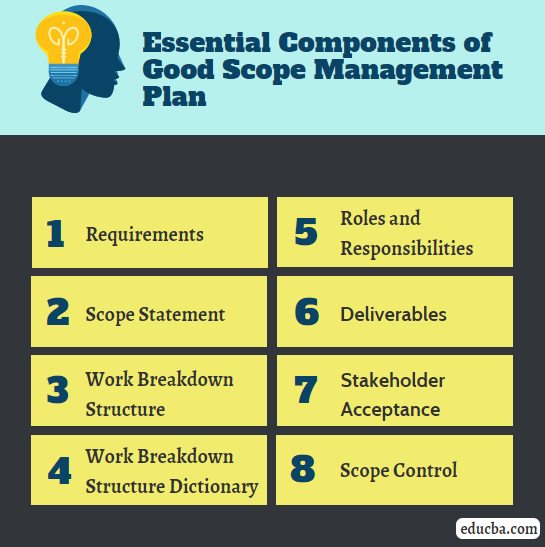
Overview of Scope Management Plan
Scope Management can be defined as a collection of processes that are required in a project to make sure that all the necessary work required to complete the project is included and all the unnecessary work is excluded. Now, how the project scope is defined, developed and verified in detail in the Scope Management Plan, which clearly defines that who will be responsible for managing the scope of the project and thus act as a guide in the managing and controlling process.
Scope Management Plan, which is a fundamental of the project or program management plan can be described as a plan that defines, develop, monitor, control and verify the scope of the project. How the project scope/outlook will be monitored and controlled is described in the area from the plan. It guides how the work breakdown structure (WBS) is created from the defined statement of project scope and how to maintain and approve the work breakdown structure.
The project management plan consists of a plan and scope baseline. How the output of the completed project obtained will be formally accepted is specified by the scope management plan. Along with the other elements of project management like requirement management plan, cost management plan, process improvement plan, quality management plan, and more, the plan is also updated.
The most important benefit of this plan is that it defines and gives instruction and leadership on how to manage the scope through the whole project. It is one of the most important inputs of the project management plan process and other processes. How project teams will complete the requirement to be put together for their project is also given clarity on by the Scope management plan.
Scope Management Plan consists of:
- Scope planning
- Execution
- Control
Scope management is a part of the project management plan process, tries to answer the following questions:
- How can the scope be achieved by the project?
- To accomplish the scope of the project, what tools are required?
- For accomplishing project scope, what environmental factors of an enterprise are required?
- What are the assets of the organizational process that are required?
- Throughout the project, how the scope is handled and restrained?
For scope management, organizations shall have arrangements, standards, or forms, as these are demanding for any project. Every scope management plan is unique, though they may have topics that can be regulated for all the organizations. To guide and measure the project until its closing, the scope management plan is used as a baseline by the project managers. As mentioned above, it is a part of project management. A plan could be in different stages, during project planning, unlike other knowledge areas, which are developed at one time. How to define the scope/outlook is first determined by the project manager.
How the scope will be accomplished and composed is decided by the head of the project after getting enough information once the project is completely planned. It consists of such decisions. The project head can use another form of emphasis. The Plan is changed by the later parts of project planning, like the Human Resource process planning, which can add new scope to the process. To create a scope management plan, a good perceptive of the scope of the project is expected of the project manager. First, the output and project capacity is identified, then only you can start working on the project. Making a plan is a necessary part of project management.
No. 1 reason for project failure is because of the scope issues. How the scope will be defined, developed, monitored, controlled, and verified is described by a scope management plan which is a component of the project management plan.
Essential Components of a Good Scope Management Plan
- Requirements: A requirements identification step will be allowed for a proper scope identification process where you can prioritize and identify all the external requirements of the project, including contacting the stakeholders and meeting them if required, without missing anything.
- Scope Statement: A project is defined by the scope statement. A scope statement which is the core of the scope management plan, contains a written description of the project scope, assumptions, major deliverables, and constraints. It mentions in written that what work is important and will be the part of the project, and what will not, and shall not underestimate its importance.
- Work Breakdown Structure: The division of the project into tasks is called Work Breakdown Structure (WBS). It forms the base of modern project management techniques for schedule and budget progress called earned value management; each task is analyzed throughout the project.
- Work Breakdown Structure Dictionary: By itemizing 1) Identification number, 2) Description of work, 3) Responsible organization or individual, for each work item, a WBS dictionary supports the Work Breakdown Structure. Apart from these details, other items might include start date, budget, deadline, milestone, client or other resources necessary for continuing with the work item.
- Roles and Responsibilities: Each part of the scope, be it any person in the project team, be it a manager, junior technologist, the technical expert, should be connected to the task lead. Though all the roles and responsibilities should be known as the project outset, if the project scope changes, responsibilities can be changed throughout the project.
- Deliverables: Mostly, the deliverables are physical, but sometimes there can be non-physical deliverables as well, like the improvement of a redesigned product or an assembly line process. All output shall be identified as a part of the plan, as they represent the items that the project has been commissioned to use.
- Stakeholder Acceptance: Acceptance of the product or output is an integrated part of the scope definition process. After identifying the deliverables and itemizing the work breakdown structure, the process is completed only after the product/deliverable is seen and approved by the Stakeholders.
- Scope Control: The scope control process is important; even though the scope is identified to a minute precision, but there could still be storm clouds on the horizon.
Recommended Articles
This has been a guide to the Scope Management Plan. Here we discuss the overview and components of a good scope management plan. You can also go through our other suggested articles to learn more –

